Consumer attitudes
To mark the launch of the Scottish Food & Drink Awards 2022, our research partner 56 Degree Insight has published some original research that reveals the latest insights and trends in attitudes and behaviours amongst Scottish food and drink consumers.
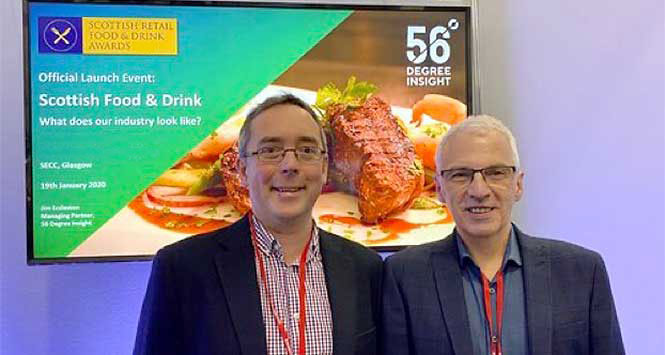
The Scottish food and drink industry continues to contribute a massive £14 billion per year to Scotland’s economy – one of the most significant contributors which places it as a key growth sector in the Scottish Government’s Economic Strategy. This also reflects its contribution to employment with almost 19,000 individual food and drink businesses in Scotland employing over 115,000 people!
But what sets the Scottish food and drink sector apart?
The Scottish market is unique making it a challenging but also an exciting place for food and drinks producers – Scots make more shopping trips than people elsewhere in the UK for food and drink each year, spending slightly less on each occasion. This results in a unique retail structure in Scotland.
But of course our world has changed enormously over the last 18 months. Following the first ‘stay at home’ lockdown due to the Coronavirus pandemic in March 2020, our daily lives, thought patterns, behaviours and habits have been hugely impacted.
In that first lockdown, there was an initial sense of novelty and a feeling that it was a short term requirement and this led to increases in several activities and behaviours. Everybody seemed to be baking bread, many parents learned new teaching skills as home schooling became the norm, and most of us rediscovered our local environs as we were allowed to take limited exercise close to home.
But then things started to open up and we had a greater degree of normality by July and throughout the summer of 2020, albeit difficulties and restrictions around travel meant that fewer of us enjoyed summer holidays, and only small numbers chose to go overseas.
And of course, as 2020 drew to a close, COVID transmission rates increased significantly and the new variants of the virus led to major restrictions around the Festive period last year and a return to full lockdown for the first quarter of 2021.
Although our world has opened up significantly since then, the restrictions over the last 18 months have undoubtedly led to major behavioural changes around consumption and shopping, some of which are likely to continue in the short and medium terms. As we prepared for the launch of the 2022 Scottish Retail Food and Drink Awards, the time felt right to understand how Scottish consumers’ attitudes in terms of food and drink choices and purchasing behaviours have evolved. We were delighted to undertake a bespoke survey for the Awards – the largest of its kind undertaken in Scotland in recent years. We interviewed a nationally representative sample of over 700 Scots using the Dynata Consumer Panel about all aspects of Scots’ attitudes and decision-making around food and drink, and we will be undertaking regular ‘deep dives’ over the next few months to explore key issues in detail. We will begin however with an overview of the key trends and behaviours that have emerged.
The search for the healthier option has become much more prevalent and continues to evolve – our survey now suggests that eating healthy food is now important to 90% of Scots – and for over half, it is either ‘very’ or ‘extremely important’:
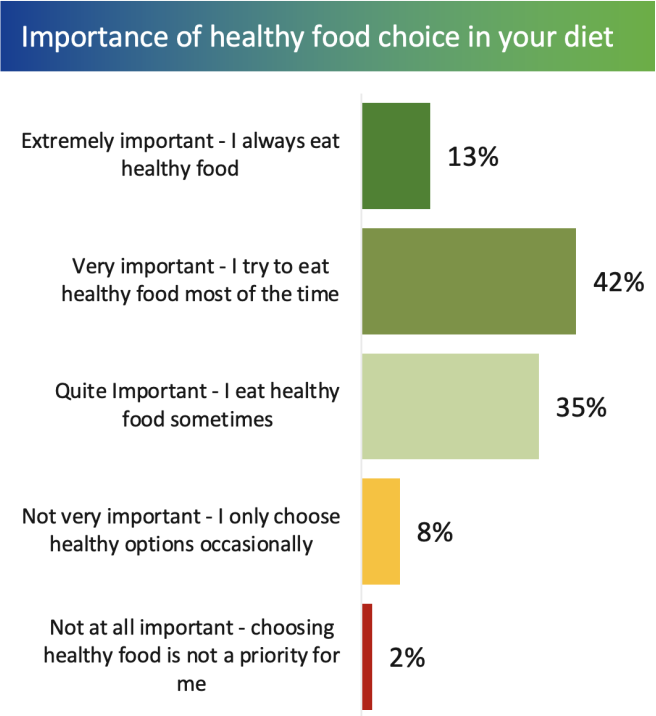
And this importance has grown – over a quarter say it is much more important to them now than a few years ago (26%) whilst over a third say it is a little more important (34%). Only 1% say it is less important to them now than it used to be.
And this desire for healthier food choices is also one of the influencers in an increasing number of Scots choosing a more flexible diet.
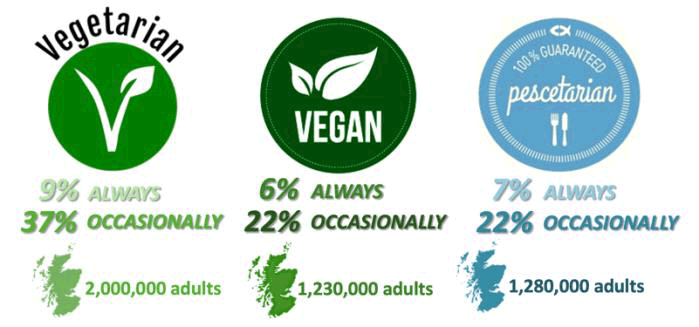
Whilst 9% of Scots adults are Vegetarian all of the time, a further 37% occasionally make vegetarian choices. This amounts to almost half of the Scots adult population choosing a flexitarian diet at least on an occasional basis (46%) – around 2 million people! There are also increases in those making occasional Vegan and Pescatarian choices: food retailers and producers need to be aware of these changes in our dietary decision- making as they provide many new opportunities.
Over the last couple of years, our food shopping habits have changed as the environmental context of the Pandemic has dictated what has and hasn’t been possible. We asked Scots how often they had shopped across a range of different channels over the last year or so.
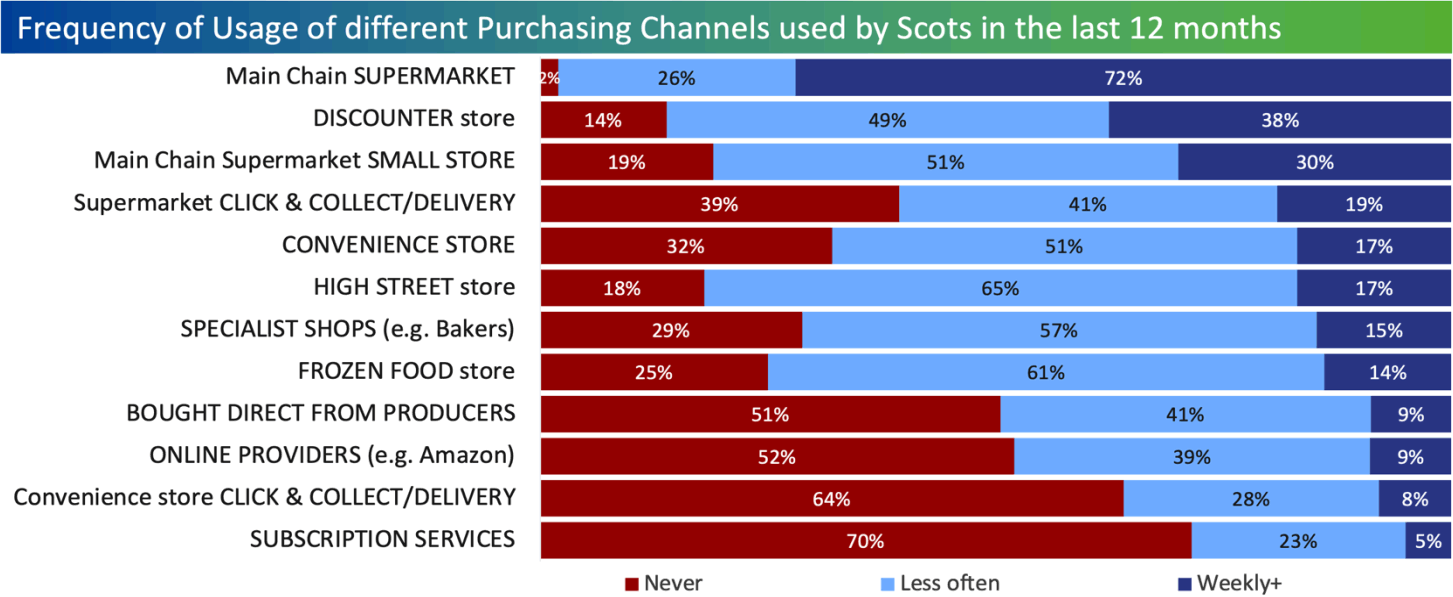
What is clear is the dominance of the main supermarket chains within the marketplace. 98% of us had shopped there at some point – and 72% of us had done so weekly or more often over the period.
The major Discounters have also been popular – 86% of us have visited at some point and 38% weekly or more often.
What is also clear however is the importance of local convenience stores. Although we don’t tend to use them so frequently (17% weekly or more), over two thirds of us do buy food and drink from convenience stores at some point (68%). Even subscription services (menu clubs, monthly food and drink boxes etc.) show some significant take up. Although they are much more ‘occasional’ purchase channels, over the last year or so, 28% of Scots have used them at some point, whilst online providers such as Amazon have been used by around half of Scots for food and drink purchases over the period (50%).
When we asked people how their choice of retail channels compared to pre-pandemic, there are some interesting trends – especially in home delivery and click and collect. The biggest increase has been in the use of this service from the major supermarkets – a net increase of 35% compared to three years ago.
There have been double digit increases across a range of channels however including Subscription services (+22%). Discounter stores (+19%), Convenience store click & collect (+15%) and the use of online providers such as Amazon (+14%):
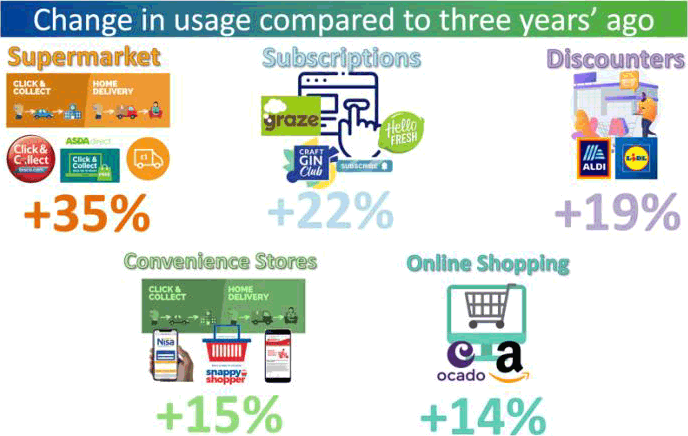
So what are the most common purchases in local convenience stores? The top 5 are illustrated below with sweet and savoury snack items followed closely by both dairy and bakery items. In contrast, supermarkets were especially popular for fruit and vegetables followed by dairy products, bakery goods and store cupboard items.
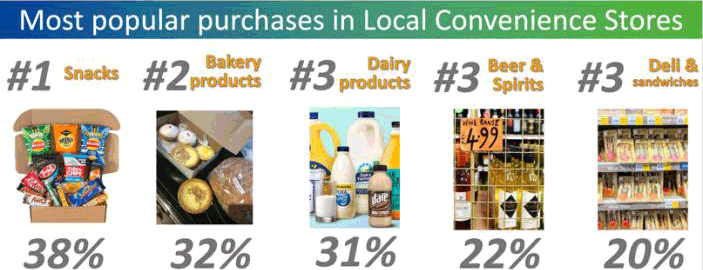
And how is retail channel usage likely to change? When asked about future intentions, only Discounters and the main supermarkets are likely to see continued increases in usage over the next few years – Scots are expecting to increase usage of these outlets by around 13%. Most other channels are likely to see smaller growth – in single digits, including local convenience stores: 11% expect to use them less, whilst 12% expect to use them more – a very small net increased usage of +1%.
So what might drive greater footfall in our local convenience stores? Amongst the population as a whole, four different elements would encourage them to shop in Convenience stores and corner shops more frequently:
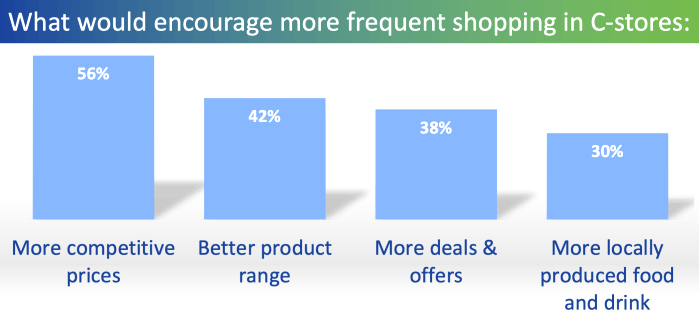
Whilst there are inevitable calls for cheaper prices and more deals and offers, three in ten would be more likely to shop locally if there was a greater range of locally produced food and drink on offer. This represents a real opportunity for local producers and retailers to work together to ensure that locally produced products can be obtained in convenience stores.
So there appears to be a real opportunity for local c-stores to stock more local products. But what does ‘local’ mean to Scots – and what types of product are especially appealing?
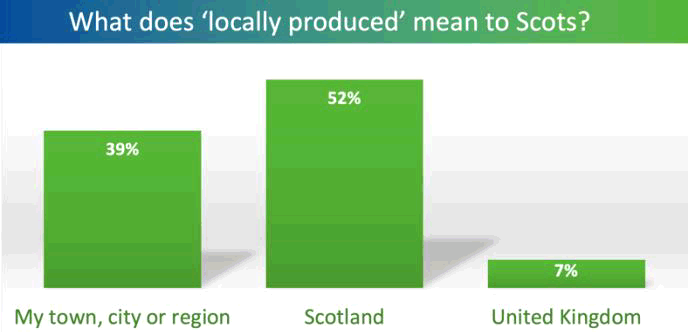
For over half of Scots, ‘local’ means ‘Scottish’ – though for a sizable minority it is more local than this – regional or even their town or city (39%). So, for producers, at the very least, to entice Scottish buyers, their products should clearly display their origins to the most local of levels as well as clearly labelled ‘Scottish’. Illustrating this, when we asked Scots about their preferences for either ‘Scottish’ or ‘British’ branding, there was little doubt that a Scottish identity was important for the overwhelming majority:

The results provided a clear direction to food manufacturers and retailers when selling Scottish produce within Scotland – the importance of using Scottish branding is clear. However, not only do Scots prefer Scottish products to be branded as ‘Scottish’, they also prefer their food and drink products to be as local as possible. In our survey, 22% claimed this was ‘very important’ and another 41% described it as ‘quite important’.
So, there is a clear desire and demand for locally produced food and drink products. But what particular types of ‘local product’ have the greatest appeal?
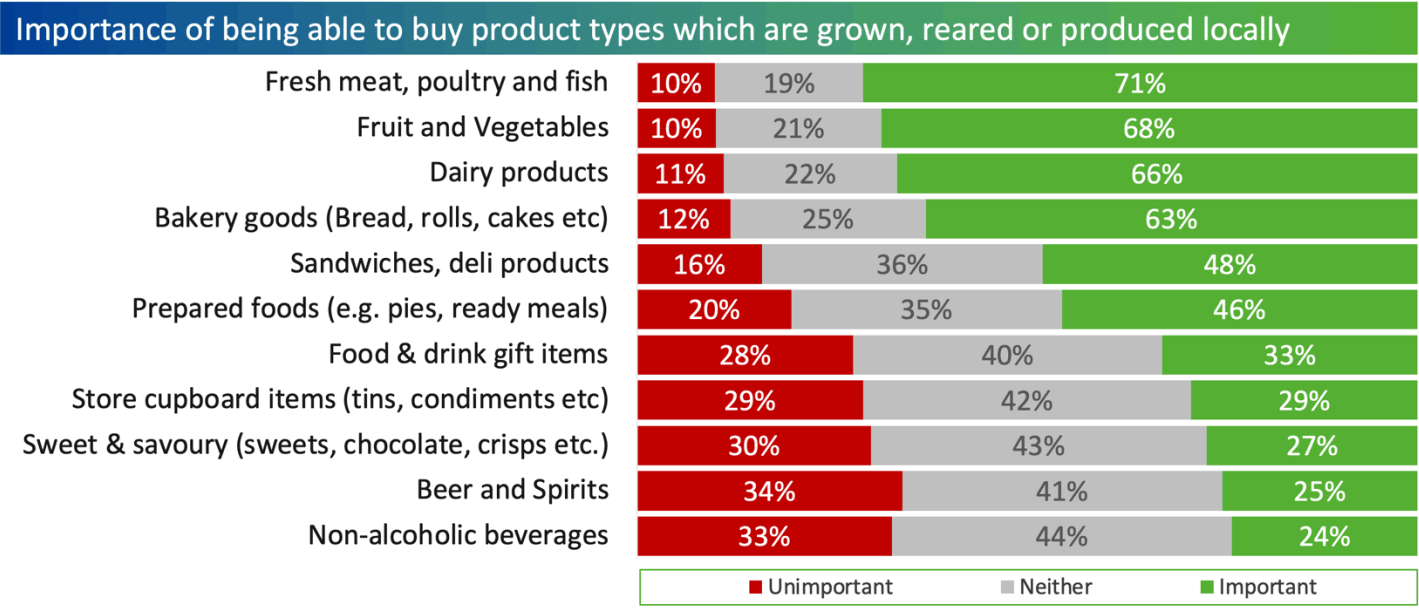
The chart above illustrates how important different product types are to Scots consumers in terms of them being produced, reared or grown locally.
Locally produced products are important to many customers in every category – even in the drinks categories towards the bottom of the chart – a local ‘marque’ is still important to a quarter of Scots.
However four categories stand out with the highest importance attributed to local varieties being readily available – fresh meat, poultry and fish, fruit and vegetables, dairy products and bakery goods: in each case two thirds of Scots or more describe locally produced/reared/grown versions being readily available as important to them.
And how have purchase of locally produced products in each category changed over the last few years?
Scots claim to now be buying more local products across all of the categories than before – but it is in the top 4 categories previously mentioned as important where there have the biggest increases – each being bought more than previously by around a third or more Scots consumers:
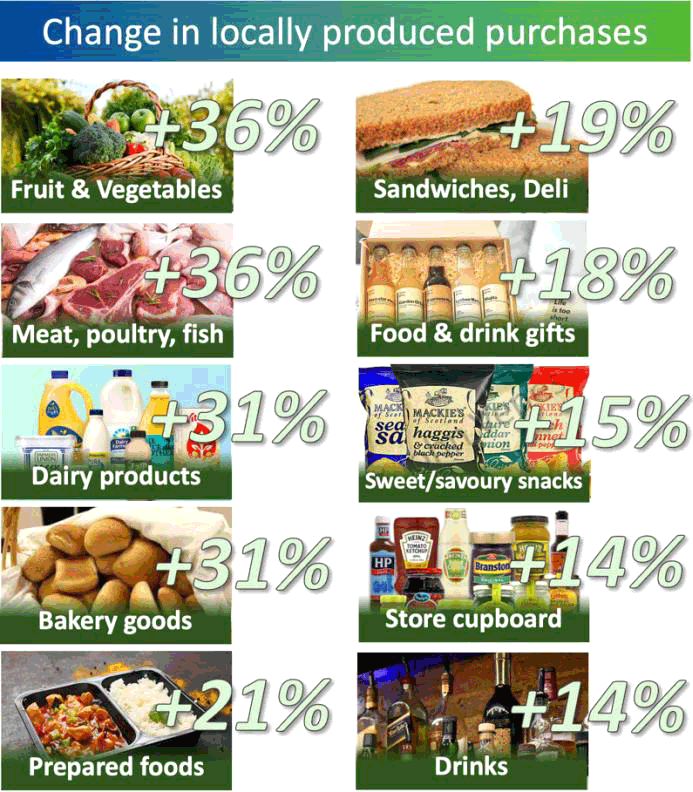
And given this interest in ‘local’, it is not surprising that Scots consumers would like to see locally grown, reared and produced products across all of the above categories more readily available to buy across Scotland. Over half of Scots consumers each mentioned three categories however where more locally produced products would be especially appealing:
- Fruit and Vegetables – 67%
- Fresh meat, poultry, and fish – 59%
- Dairy products – 56%
Ultimately, many food and drink purchasing decisions are made in the store when the products are on display in front of the consumer. So what drives these purchasing decisions?
Many are attracted to particular types of label – branded items vs own label. When we break this down further, we see the potential for own label items across all price points:
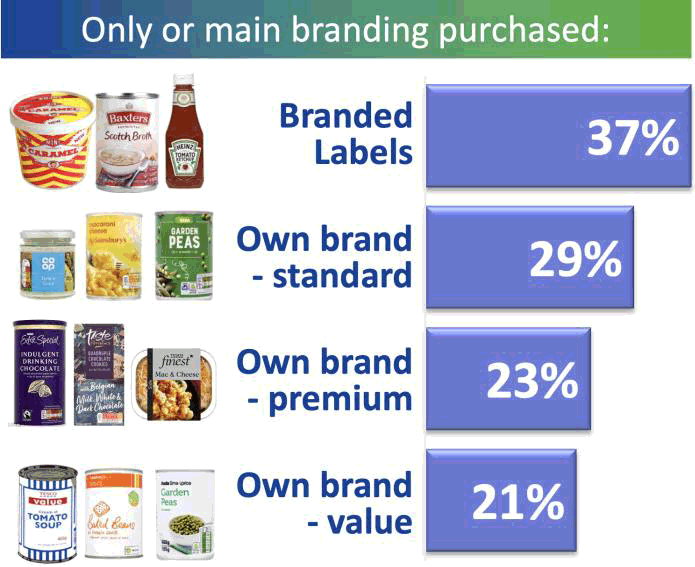
Although branded labels are the most popular individual category, when the different types of own label offers are grouped, the potential for supermarkets and convenience stores to offer their own product lines is clear.
But of course our decisions on which products to buy in store go beyond the different brand categories. And the research illustrates the range of features that are at play which compete for our spending choices.
Environmental concerns and Climate Change are playing a key role, with many stores offering plastic- free fruit and vegetable aisles and now providing paper bags instead of plastic. And this is important to Scots consumers – our recent survey of Scots showed that 66% will choose products which are plastic-free and recyclable. Linked to this, and important in the lead up to the Festive season, is the additional packaging present on some gift products in particular which is over and above what is required to hold the product.
Wherever possible, 65% of Scots would avoid these products where a more conservatively packaged alternative was available. And it goes beyond recyclable packaging – there is a clear message in the research to retailers to let their customer know when they are especially active in sustainable practices and waste reduction in store – again, 65% feel it is important they know that, and this could lead to some consumers visiting particular stores more than others.
Our survey also showed that there is greater concern about how far that food has to travel to reach the supermarket shelf: 56% of Scots seek products where food miles are reduced as far as possible. This should be clearly displayed on the label as should other sustainability information (e.g. no palm oil) – this is important to 61%.
The whole concept of buying as local as possible brings us neatly to another key trend which has rising significance – ‘provenance’ – knowing where your food and drink comes from and how it is produced is increasingly important. Our recent survey showed that 61% of Scots factor this in as part of their buying decision. This is often where telling the story of the product and the brand can be extremely effective.
Several Scottish craft gin and beer producers have used this approach effectively to draw customers in and develop an interest and intrigue about their brand. On a larger scale, the ‘family heritage’ story has been a mainstay of some of Scotland’s iconic food and drink brands from the likes of Baxter’s and Walker’s. This approach can be used to highlight the provenance of the product in an engaging way which can appeal to the consumer.
The labelling of products is extremely important – indeed overall clarity and legibility is important to 66%. As well as reassuring consumers on the factors mentioned above – sustainability, minimal and recyclable packaging and provenance, there are also other elements of the labelling and package design that will reassure consumers and make a difference in their product choice.
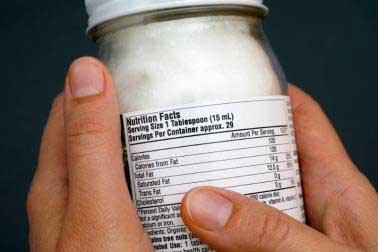
In particular, the ingredients being displayed very clearly on the label or packaging is probably the most important factor of all (70%) and of course, the overall design and the degree of ‘stand out’ of the product and label design should never be underestimated – 45% of Scots saying this is an important element of their product purchase choice.
Finally, we live in a world where awards and accreditations play a major role in consumer behaviours and decision-making. The Consumers Association have pioneered product comparisons and driven up best practice for many years and in every
walk of life we see accreditation schemes and awards – from holiday accommodation quality assurance schemes to Blue Flag awards for beaches and coastline.
And food and drink is no different – hence our enthusiasm to be a part of the second year of the Scottish Retail Food and Drink Awards. And this makes a difference to consumers: in our recent research, we asked Scots how important such awards were in food purchase decisions: 60% said it was important to know about I, and 39% would be more likely to choose products with a quality marque or award.
In summary, over the next few months, the 56 Degree Insight team will be releasing regular research and insight pieces on these and other trends affecting the food and drinks business in Scotland. Whilst the headline results will be published each month, all entrants will be able to download white papers with the full insights which go beyond the headlines.
For more information, just get in touch directly:
- Jim Eccleston 0744 703 1396 jim.eccleston@56degreeinsight.com
- Duncan Stewart 0771 786 8770 duncan.stewart@56degreeinsight.com
